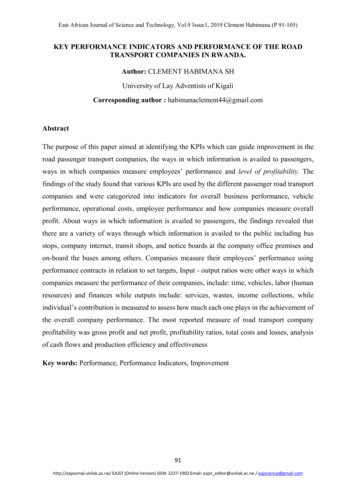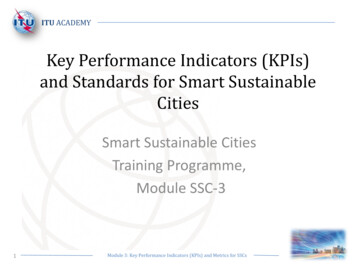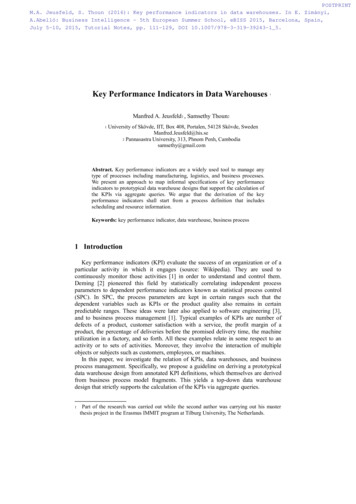
Transcription
POLITECNICO DI TORINOMaster of Science in ICT for Smart SocietiesDEVELOPMENT OF KEYPERFORMANCE INDICATORSFRAMEWORK FOR BATTERYSWAP SYSTEMSupervisors:Prof. Giulia BrunoDr.Ing. Alberto Favetocandidate: Aysan Jarvand
Table Contents2 . Abstract3 . Introduction14 . Zero Emissions34 . Review of Performance measurement systemsSec on 244 . KPI Identification66 . References1
AbstractElectric vehicles have been on the market for years as agencies of transition to a sustainabletransport system. However, due to its characteristics, electric vehicle marketing is slow interms of limited range, long charging time, and high initial cost. Therefore, there is a need toswap batteries overtime to support a larger number of electric vehicles. In order to simulateelectric mobility and increase electrical vehicle adoption rate, the aim of this thesis is toprovide a key performance indicators framework to help the Municipalities have better insightin the appropriate key performance indicators of the battery swap charging infrastructure asan incentivizing effective decision-making tool.In order to define the framework, at the first step, I have extracted available key performanceindicators (KPIs) by properly reviewing literature in the battery swap field, and second, tobetter evaluate the impact of each KPI, I have sorted the relevant KPIs based on the relativefrequency and at the final step, the classification of KPIs has been done based on the companyhierarchical level and their relevant domain of impact including economic, social andenvironmental effect.Through the list of ranked KPIs, throughput, user satisfaction, and charging strategies have agreat impact on the performance of battery swap charging infrastructure that policymakersshould consider for optimizing and adopting electric vehicles purposes.2
IntroductionVehicles are essential for today's fast-paced lifestyle, but a rise in the number of vehicles hasresulted in the many serious environmental and management issues. Furthermore, because theyare propelled by nonrenewable energy sources there is a need to build better public transitalternatives in the future, as well as an effective vehicle management section. Dependence onfossil fuels makes them unsustainable because a large portion of them has been depleted, andgenerating them again would take thousands of years, making transportation unsustainable aswell. The idea is revolutionizing the entire car industry, which can be realized by the use ofEVs Because of the above and other causes, EVs are indeed the need of the hour. Theadvancement of EV technology must occur in parallel with the advancement of vehiclecharging technology.The backbone of the EVs is the charging infrastructure. Plug-in electric vehicles (EVs), plugin hybrid electric vehicles (PHEVs), and battery EVs (BEV) are remarkable in a variety ofways, including reduced dependency on fossil fuels, cost savings, emission-free, clean driving,noise reduction, and low maintenance. The advancement of EV technology is being hailed asa source of optimism in the electric vehicle industry. Despite the promising evidence, there aresome questions about such innovative concepts for those stakeholders who need to envisionbefore investing in electric fleet rollouts. The social hindrance which arise in existing EVowners due to scarcity in the availability of recharging stations, extended charging delay,intimidation by the underlying utility grid, and, most importantly, the inherent EV rangeanxiety (EVRA) issue. The Conductive EV charging, Inductive charging and Battery swappingsystem are among the noticeable charging techniques. The battery swapping system, i.e. thethird one, has yet to be implemented as a commercially viable option, despite rapiddevelopment in the fields of conductive charging and wireless (inductive) charging. Among all3
of them, battery swapping appears to be a viable alternative in the current situation. Theswapping of the EV battery has one major advantage: faster EV recharging. The job is simple:the car driver simply drives to a battery swap station (BSS), parks in a designated location, hasthe battery swapped automatically, and then drives back after paying. Tesla has been in themarket for over three years, and the whole process takes less than two minutes, making it fasterthan refueling an internal combustion engine car. In addition, the range offered by such servicesis like the holy grail of electric mobility. It aligns EVs' flexibility and usability with that ofcombustion vehicles.The commercial adoption of electric vehicles is the point of contention. While modern Libatteries used in EVs are powerful enough to satisfy the majority of users on a variety of trips(fast/slow, long/short drive, etc.), only a small percentage of total journeys surpass the availablerange, posing a barrier to widespread adoption. To get EV adoption going at the desired pace,the disastrous electric vehicle's range anxiety syndrome must be resolved. The deployment ofdense and reliable charging infrastructure, which allows consumers to recharge their vehiclesat regular intervals, is one viable option. However, preliminary research into specificinfrastructures already in place in developing countries (Japan, Germany, Canada, NorthAmerica, and so on) reveals that certain unavoidable pitfalls remain. Which must be dealt withand resolved. These issues could appear as a lack of charge point reliability, delays caused byqueuing at such charge points, security and management problems, and so on. To help alleviatethe EVRA and queuing at stations issues, such architectures require easy accessibility.Furthermore, the EV crowd needs an aggregation agent that configures the vehicle fleet on thefront end and controls the loads on the smart grid on the back end, with the aim of ensuring theinfrastructure's smooth operation. To shape load on the underlying power system caused by alarge EV fleet, efficient dynamic energy management mechanisms are needed. Several studieshave looked at the multifaceted dimensions of an optimal BSS implementation, taking into4
account consumers, the BSS owner, and smart grids. The configuration of a BSS, such as thenumber of batteries, chargers, staff, and other agencies, must be determined ahead of time andis based on the fleet that the BSS must operate. Since each end's resource is restricted, whetherit's the BSS owner's investment cost, the operating cost of an EV, or the grid system's burden,there should be a multi-objective optimization framework that ensures all of these are met.Municipalities and service providers are struggling to optimize the roll-out of additionalcharging points and how to optimize the usage of charging points in this phase of electricalmobility adoption. This is because the stakeholders (such as municipalities, charging pointoperators, utilities) of the Charging infrastructure have little insight into the detailedperformance of the charging infrastructure and limited insight into the possible measures (aswell as and their effect) to manage the effectiveness of the charging infrastructure.Municipalities are committed to stimulating clean air by installing charging infrastructure butneed to do so in a cost-effective way to justify their municipal investment. Similarly, at theexpense of parking spaces, the municipality needs to balance the placement of charginginfrastructure and limit citizens' complaints about under- or over-used charging points. In themeantime, the municipalities aim to promote a constructive business case for charginginfrastructure, to ensure that the energy grid can handle the added demand, and to balanceadequate access to charging points without dramatically raising the parking burden.There are a variety of issues for communities that need to be managed to some degree byvarious stakeholders in the charging infrastructure chain. This research examines the mostcritical key performance indicators (KPIs) that policymakers can use to monitor and optimizethe efficacy of BSS charging infrastructure. [1].5
1.2 EV adoption challengesLogistics and transportation (L&T) operations are an important part of global economies anda major contributor to modern societies' social and economic growth. The L&T industry'sprevalence is due to its consistent growth and effect on regional Gross Domestic Product(GDP). In response to the rise of globalization and commercial interchanges among countries,road L&T activities involving motorized vehicles have increased significantly. In regions suchas Europe and the United States, transportation consumes a large portion of the oil, and roadtransport emits a significant portion of the CO2 generated by overall transportation operation.Furthermore, in countries like the United States, the transportation sector accounts for roughly28% of overall greenhouse gas (GHG) emissions. One option for resolving this issue is theuse of less polluting modes of transportation such as plug-in hybrid electric vehicles (PHEVs)and electric vehicles (EVs), as part of an effort to enhance urban air quality, modern citiespromote fleets of vehicles to embrace alternative technologies, such as EVs. Several factorsare encouraging the adoption of these technologies, including: (i) financial incentives forbusinesses to minimize their carbon footprint; (ii) the high uncertainty of oil-based productsand the long-term cost risk associated with reliance on oil-based energy sources; and (iii) thehigh variability of oil-based products and long-term cost risk associated with reliance on oilbased energy sources. (iii) Government incentives to lower procurement costs; and (iv)developments in renewable energy technology (such as electric vehicles), which have thepotential to provide more environmentally friendly options at a price that is beginning to beaffordable.The use of electric vehicles should be a top priority for reducing primary energy consumptionfrom both an environmental and an energy perspective.6
While the advantages of electric vehicles in terms of efficiency and flexibility in energy usageare of greater concern, the EV technology is currently afflicted by a number of flaws, whichcan be summarized as follows:(i) the low energy capacity of batteries in comparison to ICEV fuel; (ii) the long rechargetimes of EV batteries in comparison to the relatively quick method of refueling a tank ofICEVs; and (iii) the lack of public and/or private EV battery charging stations. EVs struggledin the past due to exorbitant battery costs and limited driving ranges. The scope of these issueshas been significantly reduced as electric vehicles have become one of the most importantresearch fields in the automotive industry.Although the cost of replacing traditional ICEVs with EVs is currently unprofitable in mostoperating scenarios, the availability of increasingly long-lasting batteries, rising fuel costs,and lower EV purchasing costs are likely to change the picture.There are several challenges associated with the introduction of electric vehicles (EVs) intoL&T operations, which include the following dimensions: environmental, strategic andplanning, and operational.Environmental Consequences of Using Electric Vehicles (EVs)Transportation operations have side effects (externalities) such as noise emissions, airpollution, and traffic congestion, which are seldom included in existing city planningstrategies. Given that the transportation sector consumes more than a quarter of all globalenergy and that generating energy raises air pollution, these externalities must be weighed inorder to ensure the global transportation sector's long-term viability.7
Noise, air pollution, infrastructure wear, flow congestion, traffic collisions, and other causesof external costs must be included in a full overview of the issue of externalities intransportation. Nonetheless, since traffic causes noise and air pollution, the majority ofenvironmental studies are focused on these issues.Nowadays, there is widespread consensus that these negative externalities must be consideredwhen developing transportation policies and logistics strategies. The European Union, forexample, has established an infrastructure-use taxation scheme based on the principle of "userand polluter pays". The importance of reducing the environmental effects of freighttransportation activities explains the need for new technology to regulate various forms ofcontaminating emissions.Strategic and Planning Issues concerning the Use of EVsUnlike conventional vehicles, EVs need regular refueling due to the short travel distance oftheir batteries and their restricted driving range. As a result, consumers must determine howmany miles they can travel before recharging. This, without a doubt, limits their utility astransportation vehicles. As a result, providing the requisite recharging stations and integratingthem into the transportation network are critical issues to address. The following are the keyissues to be determined:The number and type of refueling stations to be established. Location of charging stations andoptimal capacity of these stations. Furthermore, businesses must analyze the effect of EVs intheir fleets in order to determine the best size and combination of vehicles to use. As a result,the size and composition of the fleet is a significant factor to consider. The following8
subsections are devoted to analyzing and explaining the effects of some of these variables inthe L&T arena.Different Kinds of Recharging StationsAs more EVs are introduced to the market, the demand for public refueling stations isincreasing. When the batteries of an electric vehicle run out, there are two options: rechargethem or replace them. There are two types of charging stations: fast charging and slowcharging.A fast refueling station can recharge an electric vehicle in less than five minutes [22], but thistype of charging can greatly reduce battery life. A slow charging station, on the other hand,takes longer to recharge an electric vehicle. Vehicles must wait from 2 to 8 hours tocompletely charge their batteries at Level 1 or 2 (110–240 V) in slow recharging stations.It takes about 20–40 minutes to completely charge a battery at a Level 3 (480 V) rechargestation. As a result, the amount of time it takes to charge an electric vehicle has been a majorfactor in public acceptance. As suggested by Li [23], one big solution might be to remove thenearly drained current battery and substitute it with a fully charged one. The procedure isknown as battery swapping. The speed is the primary advantage of the swapping model. Theentire process could be completed in under 10 minutes, which is comparable to traditionalvehicles and much faster than some fast recharging stations. Other notable characteristics ofbattery swap stations include: Depleted batteries can be charged overnight when the cost of charging is low. Providing grid-support services by centralized charging and discharging. Drivers' ability to restart their journeys in minutes with a fully charged battery.9
The slow-charging of batteries to prolong their life, and the cost savings of EVs by havingoperators provide batteries. A battery swapping model could be preferable to a batteryrecharging model because the former not only increases vehicle productivity but also reducescharging costs. Because of the limited range of batteries and the essence of battery swapping,optimizing the distribution network with a battery swapping infrastructure may be a keycomponent of any green L&T strategy. On the one hand, EV owners anticipate a shortercharging period, similar to that of refueling their current vehicles. Quick charging stations arefavored because of this requirement, but this type of charging will shorten the battery's life.Furthermore, since EV users have a stochastic charging profile, implementing centralizedcharging/discharging power in plug-in mode is extremely difficult. Some incentive strategiesmay be suggested to avoid unregulated charging, which could result in a substantial increasein peak load and negatively affect power system protection. In light of the aforementioneddifficulties, an alternative approach focused on a battery swap station has gotten a lot ofattention in recent years. The lack of unified battery specifications for different EVs, however,is an issue for battery swap stations.Recharging Station LocationAs previously mentioned, one of the most important issues to solve in order for EVs to succeedis determining the location of charging stations. As a result, it's critical to devise strategies forreducing the costs of building alternative infrastructure. This "station position problem" canbe thought of as a subset of the Facility Location Problem (FLP). The most important concernsthat facility planners have are the number of charging stations, the location of these chargingstations and the types of these facilities in terms of product range, scale, and other designfeatures.10
Capacity of Recharging StationsThe size and capability of electric vehicle charging stations has an effect on transportationplanning. Typically, the capacity of these stations is small, and within a given period of time,a station, particularly a recharging station, cannot serve more than its capacity. As a result,only a limited number of vehicles can be charged at the same time. Changing the departuretimes of a logistic company's vehicles can necessitate different recharging times. Furthermore,travelers who begin their journeys at different times can arrive at different times at a station.If a station is filled at the time indicated for vehicles to arrive, the vehicles must wait in lines.The recharge time, station capacity, and waiting time are all significant issues that have beenlargely ignored in the literature on EV station location. There are only a few works in theliterature that address any of these concerns, therefore, it is critical to develop a strategic planfor constructing recharging stations while keeping overall costs to a minimum. Stationconstruction costs, waiting time costs, and refueling costs are all included in these overallcosts. When a vehicle arrives at a battery swapping station, it asks for a fully charged batterypallet to replace the almost empty batteries it already has. A fully charged battery pallet fromthe station storage or a pallet that is just finishing its charging could both satisfy the request.If the request is granted, the vehicle may drop off a completely or partially used pallet.If the station has any unused battery pallet chargers, the spent battery pallet is placed on oneof them and the recharging process begins; otherwise, it is placed in a queue before a batterypallet charger becomes available. If, on the other hand, the station does not have a fullycharged battery, the vehicle can leave and go to another station. It could also wait for a batteryto charge fully, which could take some time. If required, the vehicle may also take a newbattery that is only partially charged and use it to drive to another battery swap station alongits path. In this situation, the vehicle would be forced to stop sooner than expected, which has11
an impact on route planning, as some stops at stations were predicted, but the vehicle isunexpectedly forced to conduct other not covered stops. The size and cost of the station willvary depending on the number of battery pallet chargers the station has and the number ofbattery pallets it keeps on hand. The number of charged battery pallets available at any giventime is determined by the size of the station, the inventory of pallets on hand, and the currentdemand for charged pallets. Since the driver may not have to pay for a battery swap, the stationincurs an indirect expense from the unavailability of charged pallets when an EV arrives foran exchange, and there could be a loss of goodwill from the unserved consumer. In designingthe battery swapping infrastructure, models to quantify overall direct and indirect costs forpotential decisions on station sizing and inventory keeping would be extremely useful.Economic Issues of EVs adoptionThe scarcity of refueling stations is a significant impediment to the success of electric vehicles.The establishment of facilities to allow recharging is a pressing issue due to the limited rangeof batteries. The need for infrastructure services such as battery swapping and recharging isdetermined by two crucial factors: regular driving distance and battery range. Economicconsiderations are very critical in deciding the number and location of stations due to the highcapital costs involved in infrastructure investment. To serve EV trips economically andefficiently, studies must work to provide a theoretical basis for station deployment, such aswith a facility position model. Location problems, in general, are problems involving theallocation of spatial resources to one or more service facilities serving a spatially dispersedcollection of demands. The aim is to locate facilities in order to achieve a spatially based goal,such as reducing average travel time or reducing the gap between demands and facilities.12
1.3 Current Market of Electric VehiclesGreenhouse gases and other particles are the main problems we face with the use of internalcombustion engine (ICE) vehicles. For this reason, and since natural oil and gas reserves arebound to deplete, albeit, in the long term, governments across the globe are taking action tominimize the emissions caused by vehicles. In densely populated countries like Japan andSingapore, the government discourages the use of personal vehicles. These countries havemade excellent public transport available to the central areas of the country and imposed heavytaxes on personal vehicles, or banned personal vehicles from entering the central parts of theirkey cities. Other governments aim to lower the emissions per vehicle. They have issued newemission standards for the vehicles and require companies to meet the goal by the given time.In recent years, we have seen many governments encouraging their citizens to buy and useEVs as their main driver. Countries have put up tax breaks upon buying an EV, they areoffering subsidies, helping companies build free charging stations for EVs, have waived offtaxes on the import of electric vehicles, offered limited access to the dense parts of the citiesonly to EVs and much more. These policies are working and recent times have seen rapidgrowth in the global market share of EVs.13
The figure above shows the rapid growth of EV share in the global market. It is projected byvarious studies that by 2040, EVs will make a quarter of the global vehicles market share andmore than half of the new sales of vehicles. It is, therefore, critical to understanding theproblems faced by the users of electric vehicles in adopting EVs as their main drivers so thatpersonal vehicles can also join in the quest towards zero emissions and a booming economy.Zero EmissionsBefore we go into the detail of the charging problem, let's look at the main types of EVsavailable in the market right now and their emission rates.The figure above shows the main types of vehicles available in the market. ICEInternal Combustion Engine vehicles run directly on fossil fuel and do not have anelectric motor in them. They have served a critical role in the progress of the worldbut they are also one of the major causes of environmental degradation. Any extendeduse of them is unsustainable, environmentally and economically speaking.14
HEVHybrid Electric Vehicles mainly run on fossil fuel but the extra energy, such as whileidling and braking is used to charge an internal battery that can power an internalelectric motor. These vehicles can cover very small distances on battery but extendeddistances need fossil fuel usage. Studies have shown that HEVs can produce 25%30% fewer emissions than ICE vehicles. PHEVPlug-in Hybrid Electric Vehicles run on the same principle as HEVs, with the extraoption to charge the internal battery with external electric power. With theencouraging use of these vehicles, we can see as much as 50% fewer emissions in cityareas and around 30% fewer emissions over extended distances. BEVBattery Electric Vehicles are our main area of interest. They completely run on thebattery and have no combustion engine amounting to zero emissions to theenvironment. In the paper, we will use the terms EV and BEV interchangeably. Theonly downside of using BEVs over any other kind of vehicle is that you lose thebackup option of a combustion engine and high charge times can be a problem forcritical situations.1.4Charging options of electric vehiclesIn this section we review possible charging methods for electric vehicles. There are three mainapproaches for charging electric vehicles:15
Wired ChargingWired charging is the most basic and intuitive way of charging an EV. The vehicle isconnected to a power terminal with a wire that charges the battery pack inside thevehicle using AC or DC, depending on if the rectifier circuit is in the power terminalor the car. In the wired method, the battery is charged at different rates. While the mostwidely available option, wired charging can take 10 hours to just under an hour tofully charging a discharged battery, depending on the wired charging technology beingused and the size of the battery. Better than nothing, but it doesn't compare with thealternate gasoline solutions which can fill the tank in under ten minutes.Induction ChargingIn induction charging, the power terminal charges the battery pack inside an EV withthe help of radio waves. The power circuit is usually embedded in the ground at theparking spot of the car. This method is the most convenient; for people who park theircars in the same spot every day because the wireless charging method cannot be usedin charging stations since it is magnitudes slower than the wired method. The circuitryused for generating radio waves and then converting them back into power makes thedevice a bit complex, fragile and expensive. This charging method has its place but itis not the method we will be looking for in a system that requires high capacitybatteries to be charged as fast as possible.Battery SwappingThe final method and the only one feasible for EVs used for transportation of goodsand don't have hours every day to fill their batteries is the battery swapping. The EVpulls into a battery swap station; an automated system unplugs the battery from the16
vehicle and sends it to a charging terminal to be charged optimally, and fixes the EVwith a fully charged battery. All of this is done within 5 minutes, the same time it takesto fill a tank with fossil fuel. With the cost efficiency reaching that of ICE vehiclesand zero emissions, that is a pretty big improvement over the currently availableoptions.1.5 Structure of battery swapping systemA Battery Switching Station, or BSS, is a physical location, similar in size to a gas station,where EVs' flat batteries can be replaced with fully charged ones automatically. The batteryswapping system has many advantage over other charging method for both electric vehiclesusers and for the whole community.The removal of driving range restrictions, the transition of battery ownership and costs to BSScompanies, and the rapidity of service are the most important considerations from the user's17
perspective, since BSS eliminate the key source of delay, which is the time taken for thebattery to charge.The creation of a BSS network could be useful to the community in two ways. For instance,BSS are advocates of EV penetration in the industry, which helps in the transition to an oilfree economy. Second, the BSS is likely to become a Smart Grid component, using sparebatteries as energy storage devices and engaging in disaster recovery programs.1.6 Components and Operation of the BSSThis section discusses how a BSS system operates in depth, based on the operating modeldevised by Better Place, an American-Israeli startup that developed the first moderncommercial BSS network between 2009 and 2013.The BSS is made up of different technical components which are listed below:Swap platforms: Swap Platforms can handle one electric vehicle at a time and are fitted witha robotic arm that performs battery replacements automatically and efficiently, generally inunder three minutes.Batteries Stock: The BSS has a limited number of fully charged batteries on hand, ready tobe distributed to EVs who request a battery swap. The BSS is a closed-loop process since eachfull battery is unconditionally replaced with a depleted one.Charging Hubs: After a battery exchange in the swapping platform, the drained battery isplugged into a charging hub, where it undergoes a time-consuming charging method. The18
actual charging time is calculated by two factors: battery capacity and hub power, as shownin the graph below: Battery Energy (kWh) /Hub Power Charging Time (kW).EV: The BSS system's clients are the electric vehicles. They finally come to the switchingstation as their driving range is about to run out and request a swap.Operation of the Battery Switching Station ModelThe BSS only has a limited supply of batteries. EVs come to the BSS with the purpose ofdemanding a battery. If at least one battery swapping
in the appropriate key performance indicators of the battery swap charging infrastructure as an incentivizing effective decision-making tool. In order to define the framework, at the first step, I have extracted available key performance indicators (KPIs) by properly reviewing literature in the battery swap field, and second, to










